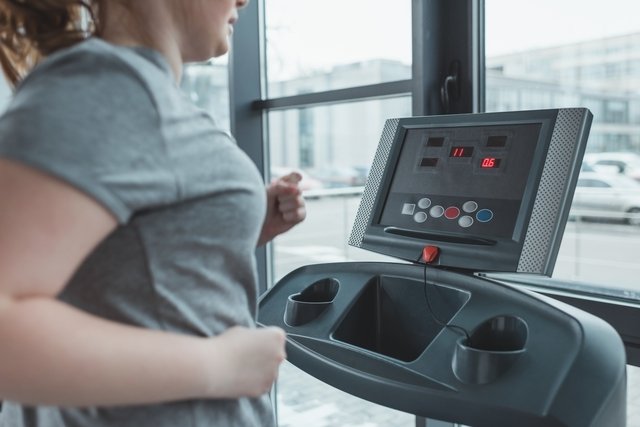When you are overweight, which is when your BMI is between 25 and 29, running should be practiced under the guidance of a physical education professional to avoid injuries and health problems. Therefore, it is recommended that before starting to run, tests are carried out to assess cardiorespiratory capacity and the health of bones and joints, for example.
Furthermore, it is necessary to strengthen your muscles, calculate your heart rate, set a goal and eat properly before and after running training to benefit from it.
Normally, running is one of the physical activities that burns the most fat and helps you lose weight faster, as fat mass is exchanged for lean mass, however it is important to run at least 3 times a week. Find out how running can help you lose weight.

Some tips that are important for those who want to run and are overweight include:
1. Plan your workouts with a trainer
Running training should always be planned by a physical trainer or coach who must establish an individual plan adapted to the person’s capabilities and limitations.
However, sometimes running may not be the first option for those who are overweight, and it may be necessary to do progressive training as can be seen in the table, starting with a light walk for around 30 minutes. Depending on the person’s progress, the trainer may recommend a jog, which is a walk at a slightly more intense pace, or a slow run, for example. Discover the main benefits of walking.
The difficulty of the training should increase gradually, as running is a physical activity with a great impact on the joints, especially the knees, in addition to requiring good heart capacity.
2. Choose the best route
You should choose to run on grass, flat dirt paths or even on a treadmill and avoid running on asphalt, as the risk of injury may be greater. Furthermore, you should choose flat paths and avoid ups and downs to make the run more effective.
3. Calculate heartbeat
It is also important to calculate the maximum heart beats per minute that occur during exercise so that the heart is not overloaded during exercise. To calculate the beats that the heart must reach during running, the following formula can be applied: 208 – (0.7 x age in years). For example, a 30-year-old person must calculate: 208 – (0.7 x 30 years) = 187, which are the number of beats per minute that the heart must reach during running.
To calculate your heartbeat, you can also use a heart rate monitor, a heart monitor or a watch with a heart band, for example.

4. Strengthen your muscles
When you are an overweight runner, it is essential to do weight training, especially the leg muscles to prevent knee and ankle injuries, which are common in runners.
This way, you can do squats, sit-ups, planks and use equipment that works the hips and muscles on the back of the leg, always with advice from the gym teacher.
5. Run together
Normally, running in the company of a colleague, friend or teacher acts as a stimulus, making the person feel increasingly capable of achieving their goals.
6. Set a goal
It is essential to define a distance, which should not exceed 5 km in the first month and which can be progressively increased. For example, you can increase 1 km each week of running, if the coach notices that the person is well conditioned. By setting the goal, the person can better focus their concentration, finding ways to overcome themselves.
7. Breathe correctly
When running, you should use abdominal breathing, using the diaphragm, inhaling for 3 strides and exhaling for 2 strides, as this allows alternating feet to be used during exhalation, avoiding the risk of injuries, in addition to greater oxygen uptake.
Before you start running
When you are overweight and want to start running, it is essential to go to the doctor to take the necessary tests and find out if you are fit to run. In this way, you must:
- Assess BMI, which is between 25 and 29 when the person is overweight. Learn how to calculate BMI;
- Assess body fat ratewhich varies with age and sex but should generally be less than 18% in men and less than 25% in women;
- Measure waist circumferencewhich must be less than 80 cm in women and 90 cm in men;
- Perform an ergospirometric testwhich assesses the level of physical fitness, the functioning of the heart and lungs;
- Take a blood test to evaluate glucose, triglycerides and cholesterol, for example.
Only after going to the doctor can the trainer prescribe a workout so the person can lose weight and run without taking any risks.
What to eat before and after the race
When you are overweight, you should consult a nutritionist so that you can choose a diet adapted to your needs. Correct nutrition is essential before and after running, as it is necessary to provide adequate energy for your needs, reduce muscle damage and promote physical recovery.
Furthermore, drinking at least half a liter of water during the run and wearing light, comfortable shoes that are appropriate to your type of stride is essential.

Sign up for our newsletter and stay up to date with exclusive news
that can transform your routine!
Warning: Undefined array key "title" in /home/storelat/public_html/wp-content/plugins/link-whisper-premium/templates/frontend/related-posts.php on line 12
Warning: Undefined array key "title_tag" in /home/storelat/public_html/wp-content/plugins/link-whisper-premium/templates/frontend/related-posts.php on line 13



